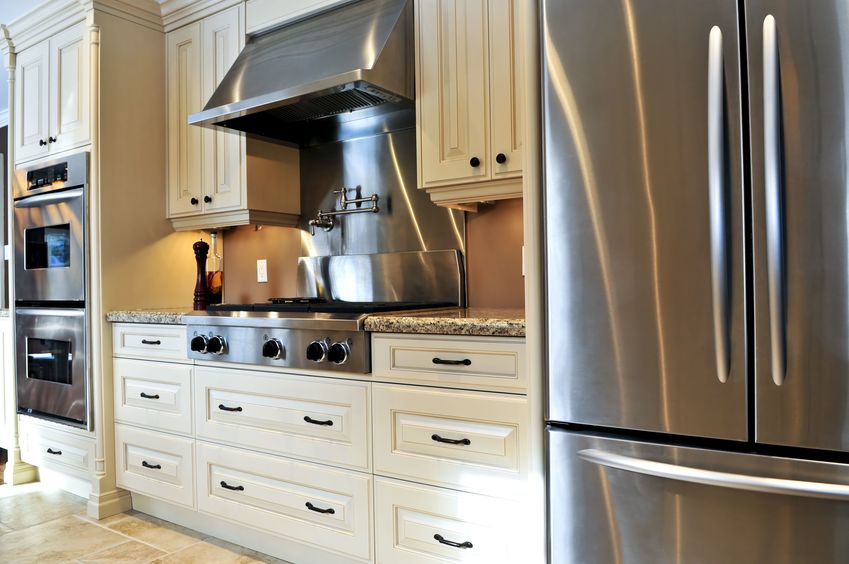Why is an extractor important?
When frying, wok cooking, and oil can deposit from the pan onto the cabinets and surrounding places making it hard to keep the kitchen clean. The kitchen extractor will remove the grease from the air and filter it via the grease filters. The extractor removes smells from the kitchen. You do not want to smell cooking that you did last night.

Tip- leave the hood switched on for a while after cooking to remove the odors. When cooking it can make steam and condensation. Have your windows ever steamed up? It can create mold. An extractor removes the steam and condensation from your kitchen.
Below are some tips to help you get the best extractor hood for your kitchen.
Set a budget
Extractors can change in price from $60 to $3,000 for some of the advanced models. Set your priorities right to set a reasonable budget for the cooker hood. A lot of people now are spending almost $800 mark on an extractor fan, and making a visual centerpiece in their kitchen.
Selecting the width
There are various hoods to fit all freestanding cookers or built-in hobs. It is better to buy and research a hood that’s the same width as your cooker and hob to ensure it works effectively. But you can fit any size as long as you have space. A few cookers and hobs that you can buy have a matching hood, but it’s down to your choice preference when it comes to selecting the best hood.
Getting the good height
The extractor should be the right height above your hob, so ensure it is correct. The space from the hood to the hob that should be left is between 65cm to 75cm.
Selecting the extraction method
You’ll decide whether you should go for a ducted-out or recirculation extraction. This will then determine where you can or cannot position it.
Extraction Hoods
Ducted or extraction hoods remove the smoke and grease out of the kitchen, sucking it out of the room through a pipe that is located outside. These kinds of fans are more efficient and faster, though can be louder. They can need to be fitted by a professional until extraction is in place.
Recirculation Hoods
Recirculation hoods recycle the air in the kitchen passing it via filters that clean the air. They feature a grease filter that is made of metal, cloth, paper. Carbon or charcoal filters are needed if you neutralize those odors as you cook. They can be fitted by yourself and are frequently cheap. It can be less efficient though there can be benefits like, being capable of place in an unsuitable location that suits your style. If you live in a flat this can be your choice.
Extraction power
In the interest of saving energy, cooker hoods can now extract a maximum of 650 m3 /h at full power. This’s the legal limit. Manufacturers can add an extra powerful boost function but it can be activated for some minutes, during which it extracts up to more than 100 m3 of air.
A hood providing the most powerful extraction capacity will have:
- A maximum power setting of about 650 m3/h
- A boost function of 1000 m3/h
- Multiple power levels
For a cheap model that is destined for a small kitchen, this rule of thumb can give you minimum extraction in m3/h”: calculate the kitchen’s volume and multiply it by a minimum of 10 (that is the length in meters x the width in meters x the height in meters x 10).
Remember, the diameter and length of the tubing, and 90o corners around which the air has to pass, are important factors that influence extraction efficiency. We suggest using 150millimeter diameter tubing and keeping it as short and straight as possible.
Noise
Cooker hoods are called ‘silent’ if they emit as low as 30 dB(A) on lowest power and 55 dB(A) on maximum. As a reference point, the decibel level of normal speech is 60dB to 65dB. The noisy hoods emit 70 dB SPL or they can emit more than that. To get a meaningful noise level comparison for 2 cooker hoods, you first make sure that both have more or less identical maximum and minimum air extraction capacities. Depending on the interpretation method used, an increase of 3dB to 6dB will double the perceived noise level. By doubling the distance (1-2-4-8…. meters) from the noise source you halve the perceived noise level. Noise levels of hoods are measured at a point of 1.3 meters from the hood’s center. The recently updated IEC standards define this and all manufacturers use this method.
Other important features to consider when buying a cooker hood
Width: Your hood must be wider than your stove. As a general rule, we suggest a hood is 1.5 x the width of the cooking area.
Height: Make sure you mount your hood high enough. It will avoid any potential discomfort to your neck/back.
Lights: LED light sources are a great solution. Try to assess whether the lights of the hood are angled correctly for you, otherwise, you risk being dazzled.
Cleaning: Filters should be accessible easily. Grease must have small places to gather, inside as well as outside the hood. Brushed stainless steel is good but greasy finger marks do show up more easily. Likewise, dust is further visible on a glass canopy than on an opaque one.
Features: A delay button with an automatic stop function is valuable. A filter alarm is highly desirable.
